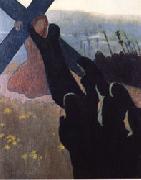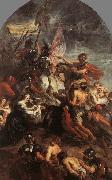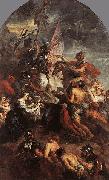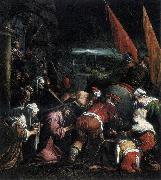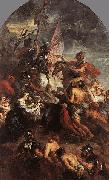Wholesale Oil Painting No Minimum |
|||||||||||
|
|
|||||||||||

|
|||||||||||
|
|
|
||||||||
Maurice Denis1870-1943 French Maurice Denis Locations French painter, designer, printmaker and theorist. Although born in Normandy, Denis lived throughout his life in Saint-Germain-en-Laye, just west of Paris. He attended the Lycee Condorcet, Paris, where he met many of his future artistic contemporaries, then studied art simultaneously at the Ecole des Beaux-Arts and at the Academie Julian (1888-90). Through fellow student Paul Serusier, in 1888 he learnt of the innovative stylistic discoveries made that summer in Pont-Aven by Paul Gauguin and Emile Bernard. With Serusier and a number of like-minded contemporaries at the Academie Julian |
||||||||
|
|
||||||||
The Road to Calvary
The Road to Calvary Painting ID:: 11662 |
November 1889
1' 1/2'' x 10''(41 x 32.5 cm) November 1889 1' 1/2'' x 10''(41 x 32.5 cm) |
|||||||
|
|
||||||||
RUBENS, Pieter PauwelFlemish Baroque Era Painter, 1577-1640 |
||||||||
|
|
||||||||
|
|
The Road to Calvary
The Road to Calvary Painting ID:: 63958 |
1634-37 Oil on canvas, rounded at the top, 569 x 355 cm Musees Royaux des Beaux-Arts, Brussels This painting was commissioned in 1634 for the high altar of the Abbey of Affligem, then one of the most important monasteries in the Low Countries. Tensions inside the monastery may explain why this monumental work was not delivered until 1637. In this production of his mature period, Rubens masterfully combines two artistic traditions. The first of these is that of the large single-frame altarpieces that were to replace the older polyptychs in the Southern Low Countries in the 17th century. With their exceptional scale and their strongly vertical format, they faced artists with the problem of constructing a convincing compositional unity from a series of related themes in a vertical format. As an artist gifted with one of the greatest compositional and narrative talents of his age, Rubens fulfilled his task masterfully. Instead of dividing the painting into an upper and lower register, a solution that he had often applied following Titian, he elects here to represent Christ's ascension to the place of his execution on Calvary in an uninterrupted zigzag movement. The thrust from below to above is achieved both in the colouring, with a balanced rhythm of localised concentrations of colour, and also iconographically, with the successive tableaux of the executioners with the two thieves, the holy women with Mary and Veronica, and ending with the Roman officers on horseback with their flapping pennants. The centre-point of the composition is Christ's face that St Veronica is wiping. Turned towards the viewer, it forms a direct call to the faithful to follow his life and to think on their own sins that had to be redeemed by Christ's suffering. This procedure descends directly from the tradition of devotional art, with small-scale pictures intended for individual meditation. The genius of Rubens' invention lies precisely in the combination of the two pictorial traditions, breathing new life into the ancient devotional tradition within a contemporary, counter-reformation form of altar decoration, whilst at the same time enriching the broad, sweeping movement of such a monumental high altarpiece with the more intimate emotionality of smaller devotional paintings. , Artist: RUBENS, Pieter Pauwel , The Road to Calvary , 1601-1650 , Flemish , painting , religiou 1634-37 Oil on canvas, rounded at the top, 569 x 355 cm Musees Royaux des Beaux-Arts, Brussels This painting was commissioned in 1634 for the high altar of the Abbey of Affligem, then one of the most important monasteries in the Low Countries. Tensions inside the monastery may explain why this monumental work was not delivered until 1637. In this production of his mature period, Rubens masterfully combines two artistic traditions. The first of these is that of the large single-frame altarpieces that were to replace the older polyptychs in the Southern Low Countries in the 17th century. With their exceptional scale and their strongly vertical format, they faced artists with the problem of constructing a convincing compositional unity from a series of related themes in a vertical format. As an artist gifted with one of the greatest compositional and narrative talents of his age, Rubens fulfilled his task masterfully. Instead of dividing the painting into an upper and lower register, a solution that he had often applied following Titian, he elects here to represent Christ's ascension to the place of his execution on Calvary in an uninterrupted zigzag movement. The thrust from below to above is achieved both in the colouring, with a balanced rhythm of localised concentrations of colour, and also iconographically, with the successive tableaux of the executioners with the two thieves, the holy women with Mary and Veronica, and ending with the Roman officers on horseback with their flapping pennants. The centre-point of the composition is Christ's face that St Veronica is wiping. Turned towards the viewer, it forms a direct call to the faithful to follow his life and to think on their own sins that had to be redeemed by Christ's suffering. This procedure descends directly from the tradition of devotional art, with small-scale pictures intended for individual meditation. The genius of Rubens' invention lies precisely in the combination of the two pictorial traditions, breathing new life into the ancient devotional tradition within a contemporary, counter-reformation form of altar decoration, whilst at the same time enriching the broad, sweeping movement of such a monumental high altarpiece with the more intimate emotionality of smaller devotional paintings. , Artist: RUBENS, Pieter Pauwel , The Road to Calvary , 1601-1650 , Flemish , painting , religiou |
||||||
|
|
||||||||
Peter Paul RubensFlemish Baroque Era Painter, 1577-1640 Peter Paul Rubens (June 28, 1577 ?C May 30, 1640) was a prolific seventeenth-century Flemish Baroque painter, and a proponent of an exuberant Baroque style that emphasized movement, color, and sensuality. He is well-known for his Counter-Reformation altarpieces, portraits, landscapes, and history paintings of mythological and allegorical subjects. In addition to running a large studio in Antwerp which produced paintings popular with nobility and art collectors throughout Europe, Rubens was a classically-educated humanist scholar, art collector, and diplomat who was knighted by both Philip IV, king of Spain, and Charles I, king of England. Rubens was a prolific artist. His commissioned works were mostly religious subjects, "history" paintings, which included mythological subjects, and hunt scenes. He painted portraits, especially of friends, and self-portraits, and in later life painted several landscapes. Rubens designed tapestries and prints, as well as his own house. He also oversaw the ephemeral decorations of the Joyous Entry into Antwerp by the Cardinal-Infante Ferdinand in 1635. His drawings are mostly extremely forceful but not detailed; he also made great use of oil sketches as preparatory studies. He was one of the last major artists to make consistent use of wooden panels as a support medium, even for very large works, but he used canvas as well, especially when the work needed to be sent a long distance. For altarpieces he sometimes painted on slate to reduce reflection problems. His fondness of painting full-figured women gave rise to the terms 'Rubensian' or 'Rubenesque' for plus-sized women. The term 'Rubensiaans' is also commonly used in Dutch to denote such women. |
||||||||
|
|
||||||||
|
|
The Road to Calvary
The Road to Calvary Painting ID:: 83528 |
Date between 1634(1634) and 1637(1637)
Medium Oil on canvas, rounded at the top
Dimensions Height: 569 cm (224 in). Width: 355 cm (139.8 in).
cjr Date between 1634(1634) and 1637(1637) Medium Oil on canvas, rounded at the top Dimensions Height: 569 cm (224 in). Width: 355 cm (139.8 in). cjr |
||||||
|
|
||||||||
Giovanni Sodoma1477-1549 Giovanni Sodoma Galleries |
||||||||
|
|
||||||||
|
|
The Road to Calvary
The Road to Calvary Painting ID:: 83574 |
Date ca. 1510(1510)
Medium Oil on wood
Dimensions Height: 36.5 cm (14.4 in). Width: 62 cm (24.4 in).
cjr Date ca. 1510(1510) Medium Oil on wood Dimensions Height: 36.5 cm (14.4 in). Width: 62 cm (24.4 in). cjr |
||||||
|
|
||||||||
Follower of Jacopo da Pontepainted Christ in the house of Martha and Mary in 16th/17th century |
||||||||
|
|
||||||||
|
|
The Road to Calvary
The Road to Calvary Painting ID:: 84064 |
Date 1575(1575)
Medium Oil on slate
Dimensions Height: 46 cm (18.1 in). Width: 42 cm (16.5 in).
cjr Date 1575(1575) Medium Oil on slate Dimensions Height: 46 cm (18.1 in). Width: 42 cm (16.5 in). cjr |
||||||
|
|
||||||||
Peter Paul RubensFlemish Baroque Era Painter, 1577-1640 Peter Paul Rubens (June 28, 1577 ?C May 30, 1640) was a prolific seventeenth-century Flemish Baroque painter, and a proponent of an exuberant Baroque style that emphasized movement, color, and sensuality. He is well-known for his Counter-Reformation altarpieces, portraits, landscapes, and history paintings of mythological and allegorical subjects. In addition to running a large studio in Antwerp which produced paintings popular with nobility and art collectors throughout Europe, Rubens was a classically-educated humanist scholar, art collector, and diplomat who was knighted by both Philip IV, king of Spain, and Charles I, king of England. Rubens was a prolific artist. His commissioned works were mostly religious subjects, "history" paintings, which included mythological subjects, and hunt scenes. He painted portraits, especially of friends, and self-portraits, and in later life painted several landscapes. Rubens designed tapestries and prints, as well as his own house. He also oversaw the ephemeral decorations of the Joyous Entry into Antwerp by the Cardinal-Infante Ferdinand in 1635. His drawings are mostly extremely forceful but not detailed; he also made great use of oil sketches as preparatory studies. He was one of the last major artists to make consistent use of wooden panels as a support medium, even for very large works, but he used canvas as well, especially when the work needed to be sent a long distance. For altarpieces he sometimes painted on slate to reduce reflection problems. His fondness of painting full-figured women gave rise to the terms 'Rubensian' or 'Rubenesque' for plus-sized women. The term 'Rubensiaans' is also commonly used in Dutch to denote such women. |
||||||||
|
|
||||||||
|
|
The Road to Calvary
The Road to Calvary Painting ID:: 87387 |
between 1634(1634) and 1637(1637)
Medium Oil on canvas
cyf between 1634(1634) and 1637(1637) Medium Oil on canvas cyf |
||||||
|
|
||||||||
SODOMA, IlItalian High Renaissance Painter, 1477-1549 Sienese painter, whose real name was Giovanni Antonio Bazzi. Born in Vercelli, Piedmont, he went to Rome c.1508. Commissioned by Pope Julius II, he painted frescoes in the Camera della Segnatura in the Vatican. Raphael's frescoes afterward replaced most of his work there. For Agostino Chigi in the Farnesina Villa, Sodoma painted two frescoes, The Marriage of Alexander and Alexander in the Tent of Darius. In Siena and its vicinity he produced many works, executed in a saccharine style. |
||||||||
|
|
||||||||
|
|
The Road to Calvary
The Road to Calvary Painting ID:: 87503 |
1510(1510)
Medium Oil on wood
cyf 1510(1510) Medium Oil on wood cyf |
||||||
|
|
||||||||
Follower of Jacopo da Pontepainted Christ in the house of Martha and Mary in 16th/17th century |
||||||||
|
|
||||||||
|
|
The Road to Calvary
The Road to Calvary Painting ID:: 87913 |
1575(1575)
Medium Oil on slate
cyf 1575(1575) Medium Oil on slate cyf |
||||||
|
|
||||||||
|
Follower of Jacopo da Ponte painted Christ in the house of Martha and Mary in 16th/17th century The Road to Calvary 1575(1575) Medium Oil on slate cyf |
||||||||
|
|
||||||||
|
Prev Next
|
||||||||
|
|
||||||||
|
Related Paintings to Follower of Jacopo da Ponte :. |
||||||||
|
|
||||||||
|
CONTACT US |
